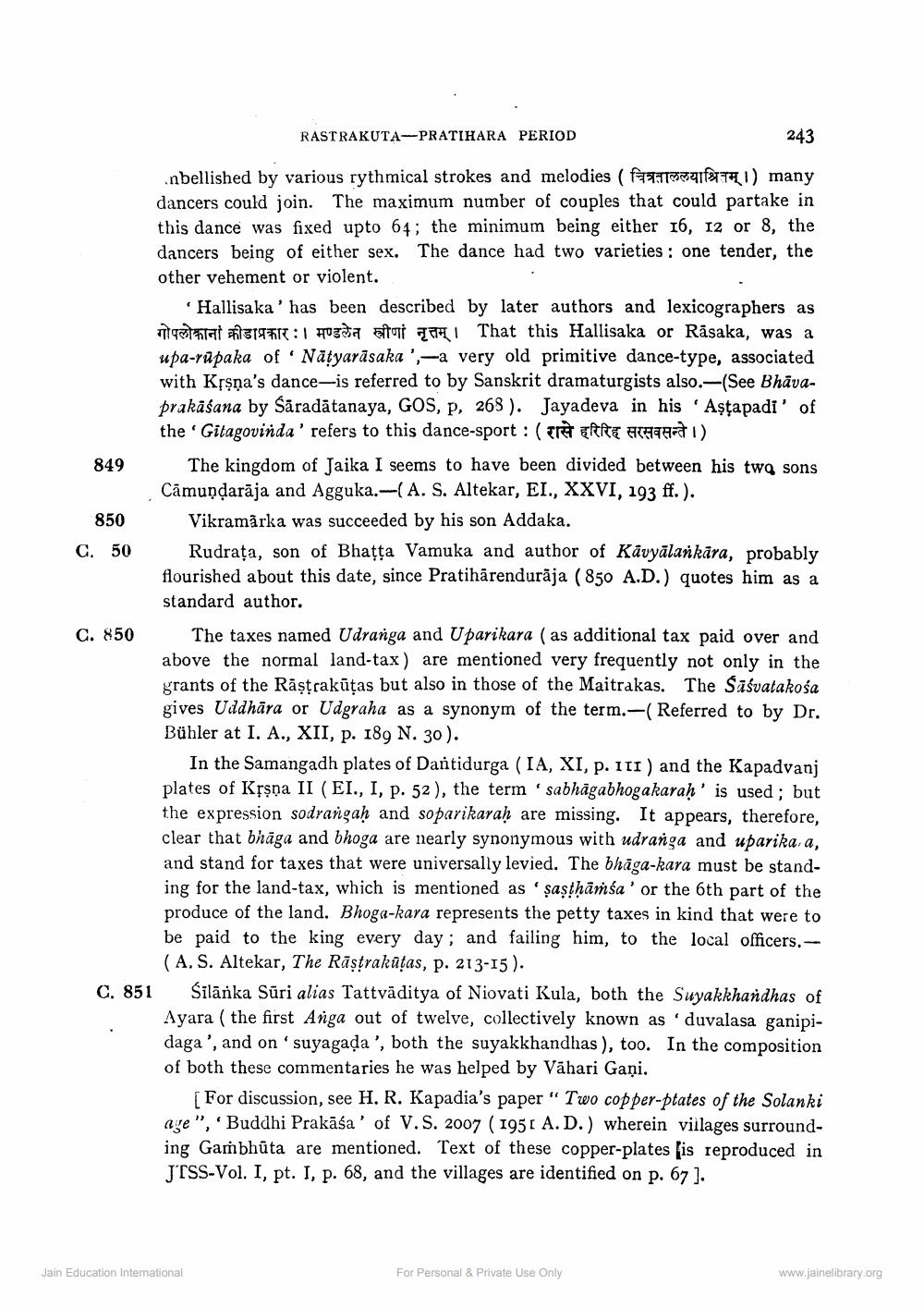________________
RASTRAKUTA-PRATIHARA PERIOD
243
nbellished by various rythmical strokes and melodies (971971) many dancers could join. The maximum number of couples that could partake in this dance was fixed upto 64; the minimum being either 16, 12 or 8, the dancers being of either sex. The dance had two varieties : one tender, the other vehement or violent.
Hallisaka ' has been described by later authors and lexicographers as गोपलोकानां क्रीडाप्रकार :। मण्डलेन स्त्रीणां नृत्तम् । That this Hallisaka or Rasaka, was a upa-rupaka of 'Natyarāsaka ',-a very old primitive dance-type, associated with Kļşņa's dance-is referred to by Sanskrit dramaturgists also.-(See Bhavaprakāśana by Sāradātanaya, GOS, P, 268 ). Jayadeva in his 'Aştapadi' of
the 'Gitagovinda' refers to this dance-sport : ( RRT Ahad 1) 849 The kingdom of Jaika I seems to have been divided between his two sons
Câmundarāja and Agguka.-(A. S. Altekar, EI., XXVI, 193 ff.). 850 Vikramarka was succeeded by his son Addaka. C. 50 Rudrata, son of Bhatta Vamuka and author of Kāvyālankāra, probably
flourished about this date, since Pratihārendurāja ( 850 A.D.) quotes him as a
standard author. C. 850 The taxes named Udranga and Uparikara ( as additional tax paid over and
above the normal land-tax) are mentioned very frequently not only in the grants of the Räştrakūtas but also in those of the Maitrakas. The Sāśvatakośa gives Uddhāra or Udgraha as a synonym of the term.-(Referred to by Dr. Bühler at I. A., XII, p. 189 N. 30).
In the Samangadh plates of Dantidurga (IA, XI, p. 111 ) and the Kapadvanj plates of Krsna II (EI., I, P. 52), the term 'sabhāgabhogakarah' is used; but the expression sodrangaḥ and soparikaraḥ are missing. It appears, therefore, clear that bhāga and bhoga are nearly synonymous with udranga and uparika, a, and stand for taxes that were universally levied. The bhāga-kara must be standing for the land-tax, which is mentioned as 'şaştņāmśa' or the 6th part of the produce of the land. Bhoga-kara represents the petty taxes in kind that were to be paid to the king every day; and failing him, to the local officers.
(A. S. Altekar, The Rāstrakūtas, p. 213-15). C. 851 Silānka Sūri alias Tattväditya of Niovati Kula, both the Suyakkhandhas of
Ayara ( the first Anga out of twelve, collectively known as 'duvalasa ganipidaga', and on suyagada', both the suyakkhandhas), too. In the composition of both these commentaries he was helped by Vāhari Gani.
For discussion, see H. R. Kapadia's paper "Two copper-ptates of the Solanki aye", 'Buddhi Prakāśa' of V.S. 2007 (1951 A.D.) wherein villages surrounding Gambhūta are mentioned. Text of these copper-plates is reproduced in JTSS-Vol. I, pt. I, p. 68, and the villages are identified on p. 67).
Jain Education International
For Personal & Private Use Only
www.jainelibrary.org




